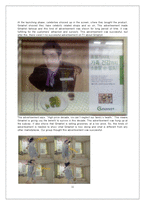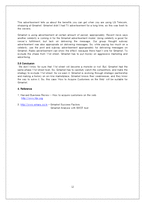[소비자행동, 마케팅] 지마켓 웹 소비자가 익히는가(영문)
 등록일 / 수정일
등록일 / 수정일 페이지 / 형식
페이지 / 형식 자료평가
자료평가 구매가격
구매가격
- 2009.08.18 / 2019.12.24
- 12페이지 /
 doc (MS워드 2003이하)
doc (MS워드 2003이하) - 평가한 분이 없습니다. (구매금액의 3%지급)
- 1,400원
최대 20페이지까지 미리보기 서비스를 제공합니다.
자료평가하면 구매금액의 3%지급!
 1
1 2
2 3
3 4
4 5
5 6
6 7
7 8
8 9
9 10
10 11
11 12
12
추천 연관자료
- 목차
-
1. Introduction.
2. Case Study – “How to acquire customers on the web”
2.1. Introduction of Study – “How to acquire customers on the web”
2.2 On to Affiliate Marketing
2.3 An Integrated Strategy
2.3.1 Radio, Television, and Print Advertising
2.3.2 On-Line advertising
2.3.3 Strategic Partnerships
2.3.4 Word of Mouth
2.3.5 Free Links
2.3.6 PR
3. Implementing this case to Gmarket (How to survive from others)
3.1 What is Gmarket ?
3.2 Status of Gmarket (Ref. Mediachannel Inc. – www.rankey.com)
3.3 SWOT
3.3.1Strength
3.3.2 Weakness
3.3.3 Opportunity
3.3.4 Threat
3.4 Problem
3.5 Solution
3.5.1 Integrated Strategy
3.5.1.1 Assuring the quality of product.
3.5.1.2 Strategic alliance (Partnership)
3.5.1.2.1 Convenient Store - Family Mart
3.5.1.2.2 Super Retail Store – E-Mart
3.5.1.2.3 Agricultural Goods Provider – Nong Hyup
3.5.1.2.4 Mobile Network Service – LG Telecom
3.5.2 Radio, Television, and Print Advertising.
3.6 Conclusion
4. Reference
- 본문내용
-
1. Introduction
The reason that we chose this case was one of our team member had a scrap book on case analysis. We took a look and looked for the material which was related to our lecture. The subject was interesting through the time we spent on team project. Web is the most popular services in Internet, so many company will ask question about “How to acquire customers on the Web”. This article was from Harvard Business Review.
2. Case Study – “How to acquire customers on the web”
2.1 Introduction of Case Study – “How to acquire customers on the Web”
Today, more than 1.6 million commercial sites operate on the Web, all in fierce competition for the attention of potential buyers. E-tailers are finding that it takes enormous marketing expenditures to set themselves out from the crowd, inspire Web shoppers to visit their sites, and then get them to actually make a purchase.
Many e-tailers, in fact, are averaging more than $100 to acquire a new customer, and some are spending upwards of $500. If a merchant is selling high-ticket, high-margin items, or if it can be sure of a steady stream of repeat purchases, those costs may make economic sense. But for most, they’re suicidal- their average customer acquisition cost is higher than the average lifetime value of their customers.
Until recently, e-tailers have been able to stake out a position in the Internet space. But the day of reckoning is now approaching. Those companies that have been able to bring their customer acquisition costs down to earth will have the best chance to thrive. Those that haven’t will die.
We’ve been studying on-line marketing for seven years, and in the course of our work, we’ve seen companies experiment with many different approaches to customer acquisition. One company that stands out in our research is CDnow, the music retailer. Although the company, like other e-tailers, has struggled to earn a profit amid the Web’s cutthroat pricing, it has been a highly popular site since its founding in 1994. It was the fourth most-visited shopping site in the fall of 1999, racking up 700,000 visitors and 5 million page views every day. During the third quarter of 1999 alone, it attracted 314,000 new customers. CDnow is currently the most powerful on-line music brand; in February it surpassed Amazon.com as the leader in total on-line buyers with more than 1million a day.
The company was one of the first to develop a multifaceted, integrated customer acquisition strategy that reflects a sophisticated understanding of the economics of an on-line business. Whatever CDnow’s ultimate fate, other virtual merchants can learn a lot by taking a close look at its strategy.
When Jason Olim was 19, a friend introduced him to Miles Davis’s classic album Kind of Blue. Entranced, Olim went searching for more of Davis’s recordings but was met with poor service and limited selection in traditional bricks-and-mortar retail sores. Out of that frustration was born a vision of a better way for music buyers to connect with music.
Some six years later in August 1994, Jason and his twin brother, Matthew, created CDnow in their parents’ Ambler, Pennsylvania, basement to provide music buyer with knowledgeable recommendations, convenience, and a large selection. In its first month, CDnow made a $14 profit from $387 worth of business
At the time, the Web was only beginning to emerge as a platform for commerce, and the main way to promote a site was to get it listed on NCSA Mosaic’s “What’s New” Page or on the Global Network Navigator’s Whole Internet Catalogue site. Then, as more e-tailers began to set up shop attention shifted to banner ads as a great way to promote its site to Web surfers.
But many of those early on-line selling efforts were conducted by magazine sales people who didn’t really understand how the new medium worked. Thinking of banner ads in the same way as they thought of a 30-second television spot or a print ad in a magazine, they sought to base their prices on the number of people who would see an ad-what in the trade is called ”exposure- based cost-per-thousand pricing .” (The shorthand is CPM, with M being the Roman numeral 1,000.) As with conventional broadcast and print advertising, this approach measures only the amount of advertising delivered, usually expressed in terms of :exposures” or “impressions,” broken down, at best, by demographic or psychographic segments. CDnow representatives found that the script for such purchases went something like this: The salesperson would say, “Take this magazine which has 100,000readers. Our Web site has 100,000 visitors. The magazine charges $10,000 for a full-page ad. Our Web site charges $10,000 a month for a banner ad.”
As the Olims very quickly realized this approach does not capitalize on the unique advantages of the Internet. On the Web, it’s not only possible to measure the amount of advertising delivered, it’s also possible to trash the amount consumed. Specif
- 참고문헌
-
1. Harvard Business Review - How to acquire customers on the web
http://www.hbr.org
2. http://www.emars.co.kr – Gmarket Success Factors
Gmarket Analysis with SWOT tool
자료평가
-
아직 평가한 내용이 없습니다.
오늘 본 자료
더보기

최근 판매 자료
- 스포츠마케팅_프로스포츠 구단(축구, 야구, 농구, 배구 등)을 1개 선정하여 해당 구단을 SWOT분석하여 다른 구단에 대한 경쟁전략을 수립하라 (3)
- [가치사슬, 경영전략] 가치사슬분석
- [마케팅] 아름다운 재단 SWOT 분석 및 개선 방안
- [광고홍보조사 설문지] 숙취해소음료의 제품과 광고에 대한 이미지
- [설문지] 기능성음료에 대한 마케팅 조사 설문지
- [국제기술이전] 국제기술이전의 개념과 효과, 특성(특징), 국제기술이전 구조와 경로
- [경제이론사] 빅토리아시대와 경제학의 지하세계
- [호텔경영조직] `Ritz Carlton` 리츠칼튼호텔 조직도 분석
- [조직행동론]서울 `리츠칼튼호텔`의 조직관리 프로그램 및 내부마케팅 분석
- 가치평가방법으로 순현가법을 설명하고, 내부수익률법과 비교하여 차이점에 대하여 설명하시오
저작권 관련 사항 정보 및 게시물 내용의 진실성에 대하여 레포트샵은 보증하지 아니하며, 해당 정보 및 게시물의 저작권과 기타 법적 책임은 자료 등록자에게 있습니다. 위 정보 및 게시물 내용의 불법적 이용, 무단 전재·배포는 금지됩니다. 저작권침해, 명예훼손 등 분쟁요소 발견시 고객센터에 신고해 주시기 바랍니다.









